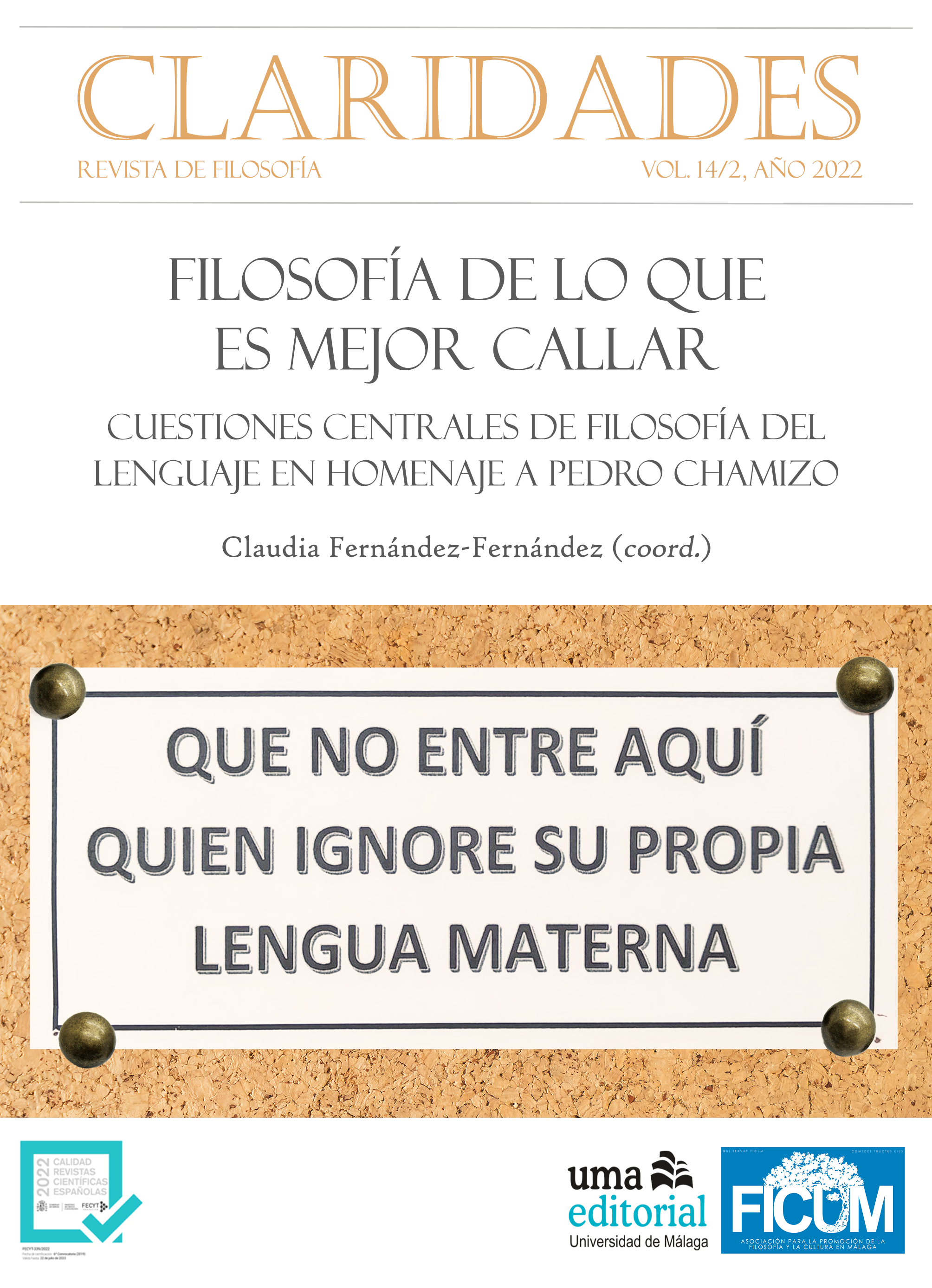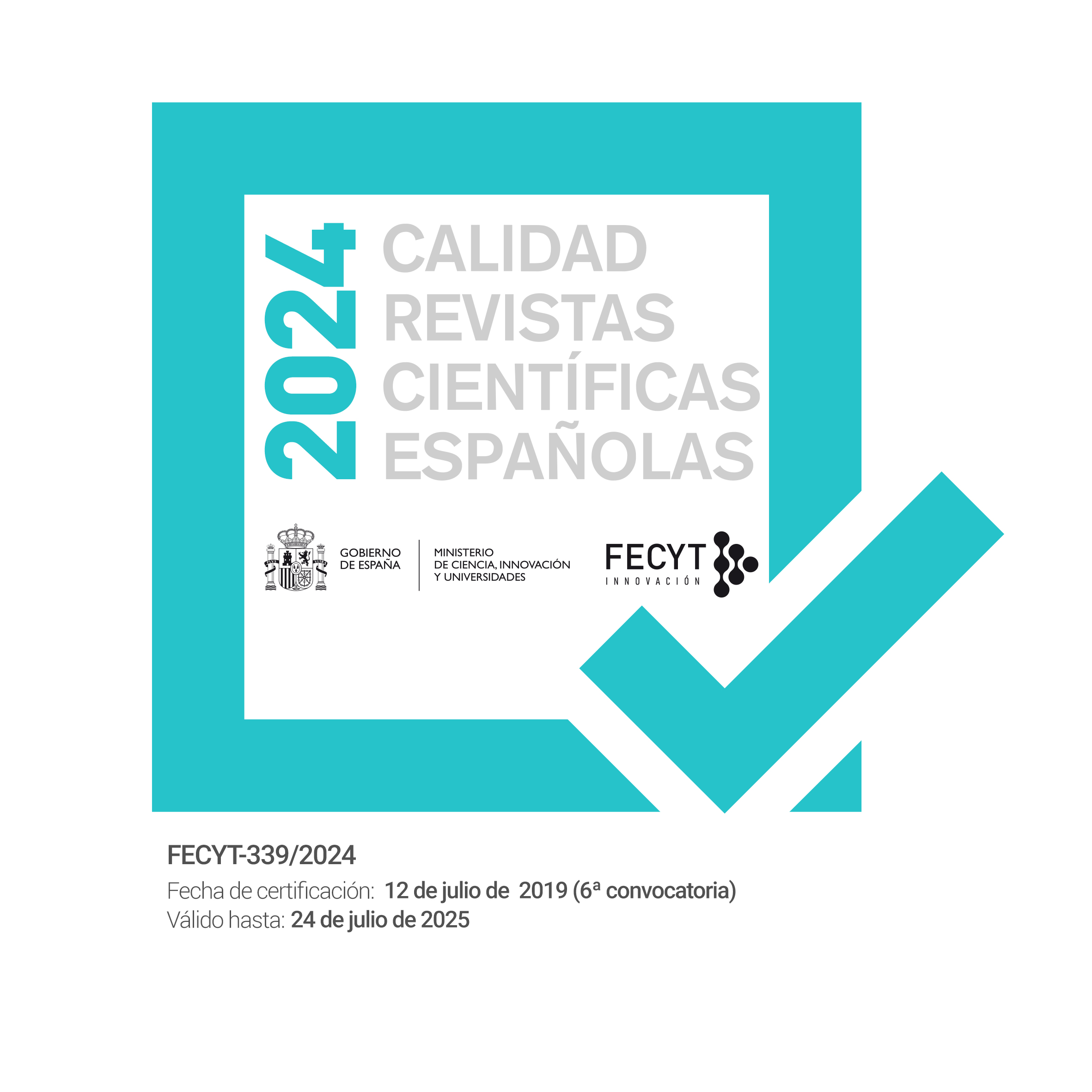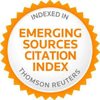La verdad es lo que el contexto hace de ella
DOI:
https://doi.org/10.24310/Claridadescrf.v14i2.13620Palabras clave:
Verdad vaga, Verdades alternativas, Verdades indiscutibles, Ideologías, ContextoResumen
Este ensayo muestra que la verdad no puede separarse de la experiencia humana y la visión del mundo de un individuo, su weltanschauung. Existen diferentes weltanschauungen que favorecen verdades alternativas. Por lo tanto, hablando libremente, la verdad está determinada por el contexto. Puede ser socialmente aceptable preferir una de las verdades alternativas como verdaderamente verdadera, pero este objetivo implica necesariamente adoptar una perspectiva ideológica sobre lo que se percibe y acepta como la única verdad. En otras palabras, depende de prejuicios. El valor de verdad asignado a la proposición God exists ilustra claramente esta afirmación, pero en el curso de este ensayo demuestro que las verdades alternativas están muy extendidas y que las verdades
en conflicto pueden coexistir dentro de una comunidad incluso cuando crean
disensión. Un grupo hegemónico afirmará una preferencia por una verdad
sobre sus alternativas, pero eso no elimina la existencia de verdades alternativas.
Los weltanschauungen alternativas deben gestionarse de alguna manera, y el
reconocimiento de que existen verdades alternativas es un paso en su gestión.
Descargas
Métricas
Publicación Facts
Perfil de revisores N/D
Información adicional autores
Indexado: {$indexList}
-
Indexado en
- Sociedad Académica/Grupo
- N/D
- Editora:
- Asociación para la promoción de la filosofía y la cultura en Málaga (FICUM) y UMAEditorial
Citas
Allan, K. (2001) Natural Language Semantics. Oxford & Malden MA: Blackwell.
Allan, K. (2018) Getting a grip on context as a determinant of meaning. In A. Capone, M. Carapezza and F. Lo Piparo (eds) Further Advances in Pragmatics and Philosophy. Part 1. From Theory to Practice, Cham: Springer, pp. 177-201.
Allan, K. (2020a) On cups. In K. Allan (ed.) Dynamic Language Changes: Looking Within and Across Languages, Singapore: Springer Nature, pp. 125-137.
Allan, K. (2020b) The semantics and pragmatics of three potential slurring terms. In K. Mullan, B. Peeters and L. Sadow (eds) Studies in Ethnopragmatics, Cultural Semantics, and Intercultural Communication: Ethnopragmatics and Semantic Analysis, Singapore: Springer, pp. 163-183.
Allan, K. (2021) [online] The interdependence of common ground and context. http://users.monash.edu.au/~kallan/papers/cg-c.pdf.
Aristotle (1984) The Complete Works of Aristotle. The Revised Oxford Translation. Ed. by Jonathan Barnes.
Bollingen Series 71. Princeton: Princeton University Press.
Davidson, D. (1967) Truth and meaning. Synthese 17: 304-23.
Durrell, L. (2012) The Alexandria Quartet. [First published 1962]. London Faber & Faber.
Einstein, A. (1973) Ideas and Opinions. Laurel edn. New York: Dell. [First published 1954].
Giora, R. (2003) On Our Mind: Salience, Context, and Figurative Language. New York: Oxford University Press.
Gray, J. (1992) Men Are from Mars, Women Are from Venus: a practical guide for improving communication and getting what you want in your relationships. New York: HarperCollins.
Grice, H.P. (1975) Logic and conversation. In P. Cole and J.L. Morgan (eds) Syntax and Semantics 3: Speech Acts, New York: Academic Press, pp. 41–58.
Hawking, S.W. (1988) A Brief History of Time: From the Big Bang to Black Holes. London: Bantam.
Hume, D. (1760) Of the standard of taste. In Essays and Treatises on Several Subjects. Vol. I. London: A. Millar, pp. 363-395.
Kuhn, T.S. (1970) The Structure of Scientific Revolutions. International Encyclopaedia of Unified Science. 2nd edn. Chicago: Chicago University Press [First edn 1962.].
Lewis, D. (1968) Counterpart theory and quantified modal logic. Journal of Philosophy 65: 113-126.
Lewis, D. (1986) On the Plurality of Worlds. Oxford: Basil Blackwell.
Locke, J. (1694) An Essay Concerning Humane Understanding: In Four Books. 2nd edn. London: For Thomas Dring and Samuel Manship.
Moore, G.E. (1902) Truth. In J.M. Baldwin (ed.) Dictionary of Philosophy and Psychology. Vol. 2, London: Macmillan, pp. 716-718.
Pirsig, R.M. (1976) Zen and the Art of Motorcycle Maintenance. London: Corgi.
Putnam, H. (1962) It ain’t necessarily so. Journal of Philosophy 59: 658-71.
Quine, W.V.O. (1960) Word and Object. Cambridge MA: MIT Press.
Searle, J.R. (1980) The background of meaning. In J.R. Searle, F. Kiefer and M. Bierwisch (eds) Speech Act Theory and Pragmatics, Dordrecht: Reidel, pp. 221-232.
Shapin, S. (1994) A Social History of Truth: Civility and Science in Seventeenth-Century England. Chicago: Chicago University Press.
Strawson, P.F. (1950). On referring. Mind 59: 320–44.
Tarski, A. (1956). The concept of truth in formalized languages. In Logic, Semantics, Metamathematics: Papers from 1923-1938. Transl. by J.H. Woodger. Oxford Clarendon Press, pp. 152-278.
Zadeh, L.A. (1965) Fuzzy sets. Information and Control 8: 338-353.
Zadeh, L.A. (1971) Quantitative fuzzy semantics. Information Sciences 3: 159-176.
Zadeh, L.A. (1972) A fuzzy-set-theoretic interpretation of linguistic hedges. Journal of Cybernetics 2: 4–34.
Descargas
Publicado
Cómo citar
Número
Sección
Licencia
Esta revista provee acceso libre inmediato a su contenido bajo el principio de hacer disponible gratuitamente la investigación al público. Todos los contenidos publicados en Claridades. Revista de Filosofía, están sujetos a la licencia Creative Commons Reconocimento-NoComercia-Compartirigual 4.0 cuyo texto completo puede consultar en <http://creativecommons.org/licenses/by-nc-sa/4.0>
Es responsabilidad de los autores/as obtener los permisos necesarios de las imágenes que están sujetas a derechos de autor.
Los autores/as cuyas contribuciones sean aceptadas para su publicación en esta revista conservarán el derecho no exclusivo de utilizar sus
contribuciones con fines académicos, de investigación y educativos, incluyendo el auto-archivo o depósito en repositorios de acceso abierto de cualquier tipo.
La edición electrónica de esta revista esta editada por la Editorial de la Universidad de Málaga (UmaEditorial), siendo necesario citar la procedencia en cualquier reproducción parcial o total.


















6.png)
